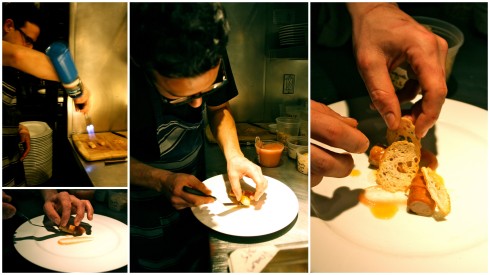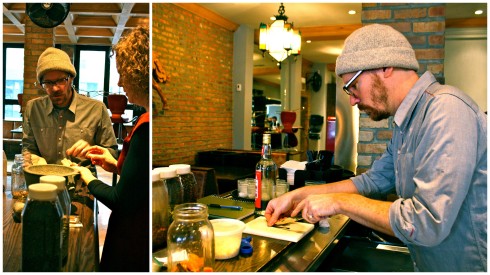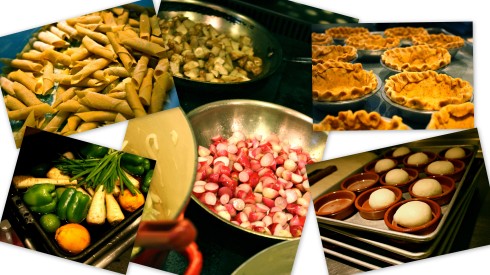For those who have been to Nightwood, you know that handmade pasta is an important part of our menu. While the shapes and styles change every week or two, our spaghetti alla chitarra remains pretty constant. I asked JV how this particular type of pasta came to be at the restaurant, and he explained that when his parents moved to Italy for a brief period of time, he asked them to send him some authentic pasta equipment … instead, they went online and found a Chitarra from a company in Pennsylvania and sent it to the restaurant. Authentic? Yes. Directly from Italy? Not quite.

Regardless of how it got here, we’re thankful for it: this type of pasta has been a steady customer favorite over the years and lends itself well to an array of ingredients and flavor combinations. The rich, all-purpose egg yolk dough is perfect when it comes to crafting hand-cut shapes like ravioli, pappardelle — and of course the spaghetti alla chitarra.
In Italian, “chitarra” (KEY-tarra) translates to guitar, and you can see from the photo above how this piece equipment resembles a small guitar — strings and all. The origins of the spaghetti alla chitarra appear to come from the center and southern regions of Italy, particularly the region of Abruzzo. There, they like to serve the spaghetti with a simple meat ragu. Though the chitarra may look slightly intimidating at first glance, it’s actually quite simple to use: sheets of handmade pasta are placed directly on top of the strings and pushed through with a rolling pin. Easy, right? Be sure to check out the video below, as JV makes the pasta and shows how to use the Chitarra.
:: INGREDIENTS ::
(yields approx. 4 servings)
- 1/2 lb. all-purpose flour (~2 cups)
- 7 egg yolks
- Pinch of salt
- Warm water (~1/3 cup, give or take)
:: METHOD ::
In a large bowl, combine the flour and salt and create a well in the center. Add the egg yolks and some of the warm water to the well. Begin to mix with fingers, slowly pulling the flour into the center of the well. Add more water as needed until dough begins to come together. Start to knead the dough in the bowl (it’s okay if there’s extra flour left in the bottom of the bowl). Once you get a good chunk of dough, remove it from the bowl and knead it by hand for about 30 minutes to develop the gluten. Now that your arm feels like it’s ready to fall off, tightly wrap the dough in plastic wrap and allow it to rest at room temperature for at least 30 minutes so the gluten can relax.

When the dough is done resting, take a rolling pin and begin to roll the dough out on a floured surface until you’ve achieved a smooth, almost leathery consistency without any cracks or crumbles. Finally, cut the pasta into desired shapes and briefly cook in salted boiling water (time depends on thickness/shape) — the spaghetti alla chitarra should take less than 1 minute to cook.
Watch the video to see JV make the dough from start to finish, plus how to use the chitarra:
A few final thoughts … this pasta dough also freezes great, so you can easily double or triple the recipe and keep it frozen until ready for use. Kitchen Tip: we suggest freezing the dough in thin discs rather than large chunks — it’ll thaw much faster when you’re ready to use it. Also consider using good quality eggs when making this dough; fresh, deep orange yolks will result in a beautiful looking pasta. If you’re interested in purchasing your own Chitarra, check out the Fante’s Kitchen Shop here.


























